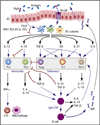The biology of intestinal immunoglobulin A responses
- PMID: 18549797
- PMCID: PMC3057455
- DOI: 10.1016/j.immuni.2008.05.001
The biology of intestinal immunoglobulin A responses
Abstract
The gut mucosa is exposed to a large community of commensal bacteria that are required for the processing of nutrients and the education of the local immune system. Conversely, the gut immune system generates innate and adaptive responses that shape the composition of the local microbiota. One striking feature of intestinal adaptive immunity is its ability to generate massive amounts of noninflammatory immunoglobulin A (IgA) antibodies through multiple follicular and extrafollicular pathways that operate in the presence or absence of cognate T-B cell interactions. Here we discuss the role of intestinal IgA in host-commensal mutualism, immune protection, and tolerance and summarize recent advances on the role of innate immune cells in intestinal IgA production.
Figures


References
-
- Andrew DP, Rott LS, Kilshaw PJ, Butcher EC. Distribution of alpha 4 beta 7 and alpha E beta 7 integrins on thymocytes, intestinal epithelial lymphocytes and peripheral lymphocytes. Eur. J. Immunol. 1996;26:897–905. - PubMed
-
- Babyatsky MW, Rossiter G, Podolsky DK. Expression of transforming growth factors alpha and beta in colonic mucosa in inflammatory bowel disease. Gastroenterology. 1996;110:975–984. - PubMed
-
- Bergqvist P, Gardby E, Stensson A, Bemark M, Lycke NY. Gut IgA class switch recombination in the absence of CD40 does not occur in the lamina propria and is independent of germinal centers. J. Immunol. 2006;177:7772–7783. - PubMed
-
- Bergtold A, Desai DD, Gavhane A, Clynes R. Cell surface recycling of internalized antigen permits dendritic cell priming of B cells. Immunity. 2005;23:503–514. - PubMed
Publication types
MeSH terms
Substances
Grants and funding
LinkOut - more resources
Full Text Sources
Other Literature Sources
Miscellaneous

